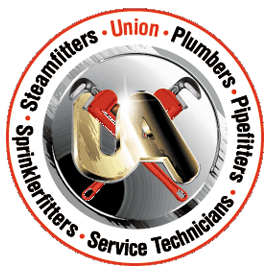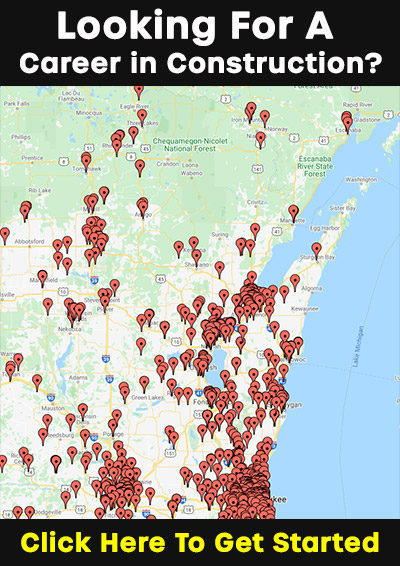United Association
Union Plumbers, Pipefitters, Welders
& Service Techs
STEAMFITTERS
Work Description
Construction steamfitters assemble, install and maintain piping systems and components that carry water, steam, chemicals, air and other fluids needed for processing, manufacturing, heating, cooling and refrigeration.
Service steamfitters troubleshoot, diagnose, repair, calibrate and maintain the components of heating, cooling and refrigeration systems as well as process systems used in manufacturing.
Working Conditions
Construction steamfitters work inside and outside, sometimes in adverse weather conditions. The work is active and strenuous requiring walking, standing, climbing, lifting and working in cramped or high areas.
Service Steamfitters work indoors in equipment rooms as well as some outdoor repair work. They use test instruments and tools in trouble-shooting and repairing of HVACR and DDC systems.
Qualifications
- High school diploma or HSED
- 18 years old or high school graduate at 17
- Possess a valid driver’s license
- Good physical condition
- Recommended high school courses: general math, algebra, geometry, trigonometry, general science, physics, mechanical drawing, welding, computer courses, English
Application Process
- Apply to Joint Apprenticeship Committee
- Submit high school transcript or HSED
- Pass as Accuplacer test
- Interview with Joint Apprenticeship Committee
Terms of Apprenticeship
- 5 year program
- 8,200 hours on-the-job training
- 540 hours related classroom instruction (paid)
- 300 hours night school on own time
- First 800 hours (6 months) are probationary period
- Journeyperson written and practical examination given at end of apprenticeship
- Wage scale systematically increases throughout the apprenticeship
PLUMBERS, HVACR Service Technicians, Fabricators, & Welders
Work Description
Today's Plumber needs to be versatile in many aspects of the plumbing industry. A plumber must be able to work on systems from residential homes to large industrial factories and large municipal wastewater treatment plants. Plumbers of today must be trained in blueprint reading, problem solving, installation and repair, leadership and communications. All of these skills are learned through an apprenticeship program that allows you to learn while you earn, meaning your apprenticeship schooling is paid for and you earn money while working and learning. Some of the fields you will be trained in are:
- Residential & Commercial Installation
- Industrial Installation
- Plumbing Service
- Potable Water Supply
- Understanding Plumbing Code
- Underground Utilities
- Waste Water Treatment
- Gas/Water/Air Piping
- Backflow Prevention
- Auto Cad
Upon completion of the Plumbing Apprenticeship you will earn 32 college credits towards an Associates Degree in Construction Supervision. Continuing Education and many Certification classes are offered for Journey persons to upgrade their skills.
Watch the video below on: The United Association of Journeymen and Apprentices of the Plumbing and Pipe Fitting Industry of the United States, Canada and Australia (UA), affiliated with the national building trades, represents approximately 370,000 plumbers, pipe fitters, sprinkler fitters, service technicians and welders in North America and Australia..
Apprenticeship Info PDF for Steamfitter, Plumber, HVACR Technician, & Fabricator ~ Click Here
Completeion of apprenticeship can lead to other careers in the piping industry:
- Project Manager
- Estimator
- Welding Inspector
- Construction Engineer
- Union Official
- Superintendent
- Business Owner
- Teacher
- Municipal Inspectors
As you can see by this list there are many opportunities to further advance a career in the piping industry. Training thru an Apprenticeship can go a long way towards making a good living here in Northeastern Wisconsin.
Find information on our website: www.ua400.org or contact:
Scott Wegner, Training Coordinator
PO Box 530, Kaukauna, WI 54130-0530
Phone: 920-462-0407
Email: scott@ua400.org
Matt Stoop, Welding Coordinator
PO Box 530, Kaukauna, WI 54130-0530
Phone: 920-462-0400
Email: matt@ua400.org
DJ Kloida, Youth Apprenticeship Coordinator
Email: djkloida@ua400.org
For More Information:
Plumbers & Steamfitters Local #400
2700 Northridge Drive, PO Box 530, Kaukauna, WI 54130
Phone: 920-462-0400 Toll Free: 800-239-1552 (WI only)
Fax: 920-462-0430
Website: http://www.ua400.org/
Doug Dokey, Business Manager
Email: Doug@ua400.org
Dustin Delsman, Assistant Business Manager
Email: dustin@ua400.org
Rob Kosky, Business Agent
Email: rob@ua400.org
Travis Martin, Business Agent
Email: travis@ua400.org
Ron Antonneau, Political Coordinator
Email: ron@ua400.org
Patrick Carlson, Organizer (WI Pipe Trades Association)
Email: uafitter400@yahoo.com
Phone: (920) 858-5496 Fax: (920) 398-1329
Plumbers & Steamfitters Local #434
Website: http://www.ualocal434.org/
Todd Bencke, Business Manager
Email: tbencke@ualocal434.org
Mitch Runge, Business Agent
Email: mrunge@ualocal434.org
912 North View Drive, Mosinee, WI 54455
Phone: 715-692-4341 Fax: 715-692-4344
Russell Boos, Business Agent
Email: rboos@ualocal434.org
Phone: 715-832-1014 Fax: 715-832-9507
Gregory Erickson, Business Agent
Email: gerickson@ualocal434.org
Phone: 715-828-3662
Chris Trickle, Business Agent
Email: ctrickle@ualocal434.org
Phone: 715-315-2455
The United Association Union of Plumbers, Fitters, Welders, & Service Techs
The United Association of Journeymen and Apprentices of the Plumbing and Pipe Fitting Industry of the United States, Canada and Australia (UA), affiliated with the national building trades, represents approximately 370,000 plumbers, pipefitters, sprinkler fitters, service technicians and welders in Local Unions across North America and Australia.
The UA has been training qualified pipe tradesmen and women longer than anyone else in the industry. We provide the premier training programs available in the industry today, including five-year apprenticeship programs, extensive journeyman training, a comprehensive, five-year instructor training program, and numerous certification programs. We help our signatory contractors grow their market share by identifying new opportunities, providing support and connecting them to the safest, most skilled and most highly trained workforce in the industry.
The United Association Union of Plumbers, Fitters, Welders, & Service Techs
Three Park Place
Annapolis, Maryland 21401
Telephone: (410) 269-2000
Fax: (410) 267-0382
Website: http://www.ua.org
History
The birth of the United Association dates back to the year 1889, when a Boston plumber named P. J. Quinlan addressed a brief letter to Richard A. O'Brien, a plumber in Washington, D.C. "Dear Sir and Brother," the letter began, "I take the liberty of addressing a few lines to you to obtain your views as regards the formation of a United Brotherhood…"
The author of the letter would become the first General President and its recipient the first General Secretary-Treasurer of the United Association.
THE EARLY 1900'S
Prior to 1889, plumbers, steamfitters and gas fitters who were organized were members of independent local unions with either no affiliation, or affiliation with a variety of trades.
By 1889, however, with existing organizations declining or becoming devoted to only one craft, local union leaders began to consider other ways to unite national pipe trades journeymen to deal with mutual problems, including how to treat traveling members, build apprenticeship, and provide strike aid.
In response to these issues, the United Association was officially born on October 11, 1889. The original name of the organization was the United Association of Journeymen Plumbers, Gas Fitters, Steam Fitters and Steam Fitters' Helpers of the United States and Canada.
At the turn of the century, early UA leaders faced new challenges and were forced to make numerous controversial and revolutionary decisions. Among these was establishment of a mechanism that would allow UA members to travel to jobs throughout the United States and Canada. The clearance card system was created to enable unemployed journeymen in one locality to travel to work in another.
This "mobility" became especially important during the early 1900's, when the construction industry entered a period of tremendous expansion. From 1898 to 1914, the UA quadruped its membership.
During these years, under the leadership of General President John S. Kelley, steps were taken to strengthen the UA on a national basis. One of those was establishment of the stamp system of dues collection. This move dramatically improved the UA's financial stability and provided a means of compiling a reliable list of affiliated local unions and their membership.
Significant progress toward a sound, modern union came in 1902 in Omaha, Nebraska, when delegates to the UA convention approved a plan to provide a comprehensive system of sick, death and strike benefits.
The UA's nationalization efforts were further strengthened during the general presidency of John R. Alpine from 1906 to 1919. His term in office was marked by extraordinary executive skills that resulted in the implementation of many important reforms and changes in an atmosphere of harmony.
THE GREAT DEPRESSION
In 1929, the stock market crashed, and thousands of banks failed. In Canada and the United States, hard times fell on UA families. The Great Depression sank our two nations into despair, as unemployment soared, families suffered immeasurably, and there seemed little hope on the horizon. Several issues of the UA Journal at that time offered advice on how members could make their wages go as far as possible, such as growing their own food in their own gardens, but much of the focus was either on calling for our two governments to take action to help the people, or on trying to offer some kind of hope and encouragement to our membership.
In Canada, as in the U.S., construction all but stopped, and this led to a significant decline in manufacturing. The economies of both nations spiraled ever downward, until unemployment reached extremely high numbers and workers began to give up altogether.
Even as life became evermore grim, UA members discovered ways to survive—from job sharing to supporting one another through donations from those who could find work. While membership declined, and no conventions were held between 1928 and 1938, the UA held it together. At the 20th Annual Convention, the General Executive Board report concluded: “There is no human institution that can record men so willing to suffer and sacrifice for each other and for principle that you can find in the labor movement.There is no higher nor nobler exemplification of supreme duty to our fellow men than to be willing to always be ready to accept cheerfully the great sacrifice and suffering … in order to help one another … It shows very clearly that our members are very conscious of the nobility of their position as workers and of their great worth to society.” This attitude certainly reflected that of the membership during these dark times.
At last, with the New Deal under President Franklin D. Roosevelt, members began to go back to work—and regain their pride. UA members helped build schools, libraries, public buildings and housing projects under the Public Works Administration and the Works Progress Administration. Their work stands today as a lasting monument to their remarkable skills—projects like Hoover and Grand Coulee Dams, and the dams of the Tennessee River Valley that brought electricity to millions in rural areas.
However, in Canada, the government’s response was not so successful. Organized work camps were set up where unemployed men were put to work building roads and other public works for very little pay. The poor conditions in these work camps led to protests and strikes. Hundreds of workers boarded boxcars headed to Ottawa to demand reform from the federal government. This became known as the “On to Ottawa” trek, but it was blocked before it could reach the city. Eventually, a new Canadian government initiated a relief program similar to FDR’s but not as successful, although the economy there did eventually begin a slow but painful recovery. However, it would take the outbreak of World War II for the economy in Canada to truly become strong again.
WORLD WAR II
By 1941, UA membership had reached 81,000. That number soared to 210,000 during World War II. Thousands of UA members enlisted in the armed forces and served bravely in conflicts all over the world. Back home, UA members were put to work in shipyards, weapons plants, aircraft factories and other facilities. Some members also served in military construction units overseas.
During these years, the UA grew in both membership and prestige. Wartime construction contributed to this rise, but other events also enhanced the strength of the UA. One of those was the development of national agreements between the UA and large, national contractors. The landmark UA-NCA (National Constructors Association) National Construction Agreement was signed in 1941.
The post-war years were also marked by the rise of one of organized labor's most prominent leaders -- George Meany, the first president of the newly-formed merger of the two principal labor organizations (the American Federation of Labor and the Congress of Industrial Organizations) into the AFL-CIO. A plain-spoken man of great courage and dignity, he was perhaps the most influential figure in shaping the American labor movement from the mid-1950's until his death in 1980. George Meany was also a proud member of United Association Local 2 in New York City.
The ties between the UA and the AFL-CIO have always been strong. The UA became an affiliate of the American Federation of Labor in 1897, and the United Association General Office in Washington, D.C. was originally built by Samuel Gompers in 1915-16 to serve as AFL headquarters. Today, the UA is one of the strongest forces within the Building and Construction Trades Department of the AFL-CIO.
A NEW MILLENNIUM OF PRIDE
From humble beginnings of 40 delegates representing 23 independent unions in 10 states and the District of Columbia, the United Association has grown to a powerful, international union representing over 370,000 members in more than 300 local unions throughout the United States, Canada and Australia. This October, we will proudly celebrate our 125th anniversary.
The UA remains a strong, vital organization comprised of thousands of highly skilled men and women who have joined together for a common purpose.




